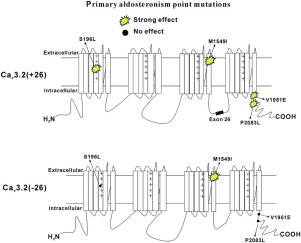当前位置:
X-MOL 学术
›
Cell Calcium
›
论文详情
Our official English website, www.x-mol.net, welcomes your feedback! (Note: you will need to create a separate account there.)
Splice-variant-specific effects of primary aldosteronism point mutations on human CaV3.2 calcium channels.
Cell Calcium ( IF 4 ) Pub Date : 2019-11-01 , DOI: 10.1016/j.ceca.2019.102104 Min He 1 , Zilan Xu 1 , Yuchen Zhang 1 , Changlong Hu 1
Cell Calcium ( IF 4 ) Pub Date : 2019-11-01 , DOI: 10.1016/j.ceca.2019.102104 Min He 1 , Zilan Xu 1 , Yuchen Zhang 1 , Changlong Hu 1
Affiliation

|
CaV3.2 calcium channels play important roles in both neural excitability and aldosterone secretion. Recent clinical studies found four germline mutations (S196 L, M1549I, V1951E and P2083 L) in CaV3.2 channels. All four mutations caused primary aldosteronism (PA), while only the M1549I mutation resulted in obvious neural malfunctions besides PA. In human, there are two major CaV3.2 channel gene (CACNA1H) splice variants, either with or without exon 26. In this study, we tested the expression of the two CACNA1H splice variants in zona glomerulosa (ZG) cells of human adrenal cortex and the possibility that CaV3.2 (-26) and CaV3.2 (+26) channels have different functional responses to the four PA mutations. We found that human ZG cells only express long form CaV3.2(+26) channels. The M1549I mutation slowed the inactivation of CaV3.2(+26) more than 5 fold, and CaV3.2(-26) more than 2 fold. The S196 L, V1951E and P2083 L mutations accelerated channel recovery from inactivation for CaV3.2(+26), but not CaV3.2(-26) channels. All four mutations resulted in gain of function of CaV3.2(+26) channels, leading to overproduction of aldosterone. In conclusion, the four PA mutations caused more profound changes on CaV3.2 (+26) currents than on CaV3.2 (-26) currents, and except the M1549I mutation, the S196 L, V1951E and P2083 L have little effect on the electrophysiological properties of CaV3.2(-26) currents, which may partially explain the limitation of the phenotype associated with the V1951E, S196 L and P2083 L germline mutations to PA.
中文翻译:

醛固酮增多症点突变对人CaV3.2钙通道的剪接变体特异性影响。
CaV3.2钙通道在神经兴奋性和醛固酮分泌中均起重要作用。最近的临床研究在CaV3.2通道中发现了四个种系突变(S196 L,M1549I,V1951E和P2083 L)。所有这四个突变均引起原发性醛固酮增多症(PA),而只有M1549I突变导致PA以外的明显神经功能障碍。在人类中,有两个主要的CaV3.2通道基因(CACNA1H)剪接变体,带有或不带有外显子26。在这项研究中,我们测试了两个CACNA1H剪接变体在人肾上腺肾小球(ZG)细胞中的表达CaV3.2(-26)和CaV3.2(+26)通道对四种PA突变具有不同的功能性反应的可能性。我们发现人类ZG细胞仅表达长形式的CaV3.2(+26)通道。M1549I突变减缓了CaV3的失活。2(+26)大于5倍,而CaV3.2(-26)大于2倍。S196 L,V1951E和P2083 L突变加速了CaV3.2(+26)通道失活的通道恢复,但没有激活CaV3.2(-26)通道。所有这四个突变导致CaV3.2(+26)通道功能的获得,导致醛固酮的过量生产。总之,这四个PA突变对CaV3.2(+26)电流的影响比对CaV3.2(-26)电流的影响更大,并且除M1549I突变外,S196 L,V1951E和P2083 L对CaV3.2(+26)电流的影响很小。 CaV3.2(-26)电流的电生理特性,可能部分解释了与V1951E,S196 L和P2083 L种系突变相关的表型对PA的局限性。但不是CaV3.2(-26)频道。所有这四个突变导致CaV3.2(+26)通道功能的获得,导致醛固酮的过量生产。总之,这四个PA突变对CaV3.2(+26)电流的影响比对CaV3.2(-26)电流的影响更大,并且除M1549I突变外,S196 L,V1951E和P2083 L对CaV3.2(+26)电流的影响很小。 CaV3.2(-26)电流的电生理特性,可能部分解释了与V1951E,S196 L和P2083 L种系突变相关的表型对PA的局限性。但不是CaV3.2(-26)频道。所有这四个突变导致CaV3.2(+26)通道功能的获得,导致醛固酮的过量生产。总之,这四个PA突变对CaV3.2(+26)电流的影响比对CaV3.2(-26)电流的影响更大,并且除M1549I突变外,S196 L,V1951E和P2083 L对CaV3.2(+26)电流的影响很小。 CaV3.2(-26)电流的电生理特性,可能部分解释了与V1951E,S196 L和P2083 L种系突变相关的表型对PA的局限性。
更新日期:2019-11-01
中文翻译:

醛固酮增多症点突变对人CaV3.2钙通道的剪接变体特异性影响。
CaV3.2钙通道在神经兴奋性和醛固酮分泌中均起重要作用。最近的临床研究在CaV3.2通道中发现了四个种系突变(S196 L,M1549I,V1951E和P2083 L)。所有这四个突变均引起原发性醛固酮增多症(PA),而只有M1549I突变导致PA以外的明显神经功能障碍。在人类中,有两个主要的CaV3.2通道基因(CACNA1H)剪接变体,带有或不带有外显子26。在这项研究中,我们测试了两个CACNA1H剪接变体在人肾上腺肾小球(ZG)细胞中的表达CaV3.2(-26)和CaV3.2(+26)通道对四种PA突变具有不同的功能性反应的可能性。我们发现人类ZG细胞仅表达长形式的CaV3.2(+26)通道。M1549I突变减缓了CaV3的失活。2(+26)大于5倍,而CaV3.2(-26)大于2倍。S196 L,V1951E和P2083 L突变加速了CaV3.2(+26)通道失活的通道恢复,但没有激活CaV3.2(-26)通道。所有这四个突变导致CaV3.2(+26)通道功能的获得,导致醛固酮的过量生产。总之,这四个PA突变对CaV3.2(+26)电流的影响比对CaV3.2(-26)电流的影响更大,并且除M1549I突变外,S196 L,V1951E和P2083 L对CaV3.2(+26)电流的影响很小。 CaV3.2(-26)电流的电生理特性,可能部分解释了与V1951E,S196 L和P2083 L种系突变相关的表型对PA的局限性。但不是CaV3.2(-26)频道。所有这四个突变导致CaV3.2(+26)通道功能的获得,导致醛固酮的过量生产。总之,这四个PA突变对CaV3.2(+26)电流的影响比对CaV3.2(-26)电流的影响更大,并且除M1549I突变外,S196 L,V1951E和P2083 L对CaV3.2(+26)电流的影响很小。 CaV3.2(-26)电流的电生理特性,可能部分解释了与V1951E,S196 L和P2083 L种系突变相关的表型对PA的局限性。但不是CaV3.2(-26)频道。所有这四个突变导致CaV3.2(+26)通道功能的获得,导致醛固酮的过量生产。总之,这四个PA突变对CaV3.2(+26)电流的影响比对CaV3.2(-26)电流的影响更大,并且除M1549I突变外,S196 L,V1951E和P2083 L对CaV3.2(+26)电流的影响很小。 CaV3.2(-26)电流的电生理特性,可能部分解释了与V1951E,S196 L和P2083 L种系突变相关的表型对PA的局限性。


























 京公网安备 11010802027423号
京公网安备 11010802027423号